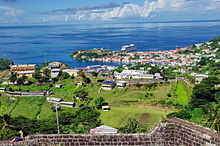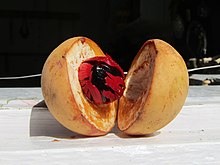 | |
| Currency | East Caribbean dollar (XCD) |
|---|---|
Trade organisations | CARICOM |
| Statistics | |
| GDP | |
GDP growth |
|
GDP per capita | |
GDP by sector | agriculture: 11%; industry: 20%; services: 69% (2008 est.) |
| 0.806% (2018)[1] | |
Population below poverty line | 38% (2008 est.) [3] |
Labour force | 59,900 (2013 est.) |
Labour force by occupation | agriculture 11%, industry 20%, services 69% (2008 est.) |
| Unemployment | 33.5% (2008 est.) |
Main industries | nutmeg, bananas, cocoa, fruit and vegetables, clothing, mace |
| External | |
| Exports | $43.8 million (2015 est.) |
Export goods | nutmeg, bananas, cocoa, fruit and vegetables, clothing, mace |
Main export partners |
|
| Imports | $310.4 million (2015 est.) |
Import goods | food, manufactured goods, machinery, chemicals, fuel |
Main import partners |
|
| Public finances | |
| $538 million (2010) | |
| Revenues | $175.3 million (2009 est.) |
| Expenses | $215.9 million (2009 est.) |
| Economic aid | $8.3 million (1995) |
| B− (Domestic) B- (Foreign) BBB- (T&C Assessment) (Standard & Poor's)[8] | |
All values, unless otherwise stated, are in US dollars. | |

The economy of Grenada is largely tourism-based, small, and open economy. Over the past two decades, the main thrust of Grenada's economy has shifted from agriculture to services, with tourism serving as the leading foreign currency earning sector. The country's principal export crops are the spices nutmeg and mace (Grenada is the world's second-largest producer of nutmeg after Indonesia). Other crops for export include cocoa, citrus fruits, bananas, cloves, and cinnamon. Manufacturing industries in Grenada operate mostly on a small scale, including production of beverages and other foodstuffs, textiles, and the assembly of electronic components for export.
Economic growth picked up in the late 1990s following slow growth and domestic fiscal adjustment in the early years of the decade. Despite an expansionary fiscal policy, the public debt remained moderate at around 50 percent of GDP as deficits were financed partly by privatization receipts. Since 2001, economic growth has declined. The decline was caused by adverse shocks, such as a slowdown in the global economy and natural disasters. To deal with the shocks, fiscal policy became more expansionary, while privatization receipts declined. As a result, public debt increased sharply to near 110 percent of GDP in 2003. Economic conditions worsened when Hurricane Ivan hit the country in September 2004; progress in fiscal consolidation was impeded as government revenues fell and policy priorities was shifted to post-hurricane relief.
Although reconstruction has proceeded quickly with significant aid from the international community, tourism and agricultural activities remain weak and nearly offset the stimulus from the reconstruction boom. The country is still facing the difficult task of reconstruction and recovery, while public debt is unsustainable and the government faces large financing gaps. In the years ahead, reinvigorating growth will be a high priority, and continued efforts are needed to address vulnerabilities.
- ^ a b c d e "World Economic Outlook Database, October 2019". IMF.org. International Monetary Fund. Archived from the original on 30 July 2020. Retrieved 22 October 2019.
- ^ Global Economic Prospects, June 2020. World Bank. 2020. p. 86. doi:10.1596/978-1-4648-1553-9. ISBN 978-1-4648-1553-9. S2CID 225749731. Retrieved 16 June 2020.
- ^ "Grenada Population Below Poverty Line(%)". CIA World Factbook. 2015. Archived from the original on June 13, 2007. Retrieved 2016-07-30.
- ^ "Human Development Index (HDI)". hdr.undp.org. HDRO (Human Development Report Office) United Nations Development Programme. Retrieved 11 December 2019.
- ^ "Inequality-adjusted Human Development Index (IHDI)". hdr.undp.org. HDRO (Human Development Report Office) United Nations Development Programme. Retrieved 11 December 2019.
- ^ "Export Partners of Grenada". The Observatory of Economic Complexity. Retrieved 10 February 2024.
- ^ "Import Partners of Grenada". The Observatory of Economic Complexity. Retrieved 10 February 2024.
- ^ "Sovereigns rating list". Standard & Poor's. Retrieved 26 May 2011.